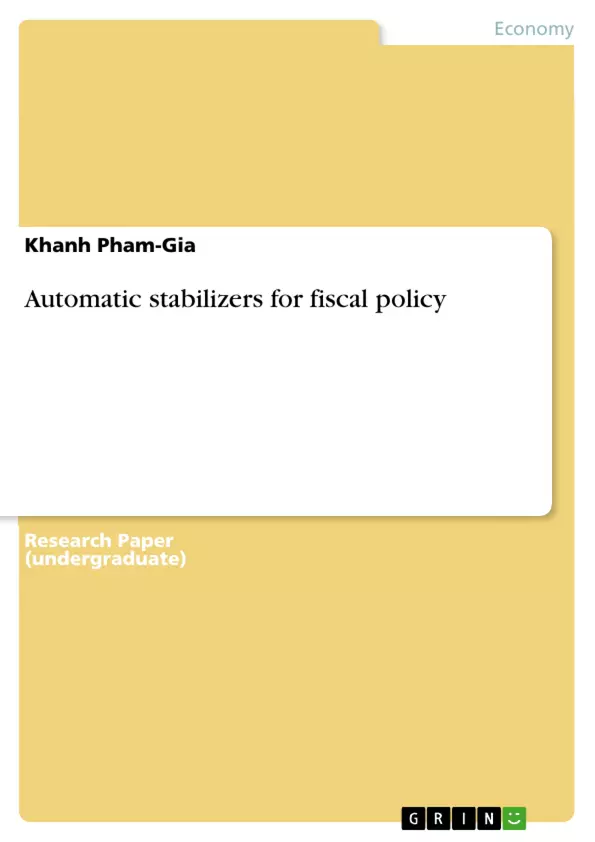The object of this study is to analyze the influence of fiscal policy, in particular of the public expenditure, on the stabilization of business cycle. Moreover, the functional principle of automatic stabilizers and the impact of fiscal stabilizers on businesses are studied.
The condition for a steady economic development is achievement of stability targets like full employment of production factors, monetary stability, balancing of payment as well as equilibrium of foreign trade. To counteract the economic fluctuations government can apply two stability tools: the fiscal and the monetary policy. These both policies affect the aggregate demand and contribute to stabilize short-run economic fluctuations.
The principle of the fiscal policy is an adjustment of public expenditure and public revenue (taxes) in according to the economic situation. A higher public expenditure leads to an increasing of the aggregate demand. The total change in GDP is depending on two opposite macroeconomic effects: the multiplier and the crowding-out effect. The multiplier effect results, that the total change in demand as well as in GDP can be a multiple of the initial public expenditure. Contrary, the crowding-out effect leads to a reduced aggregate demand due to the aligned increasing of interest rate. The impact of public expenditure on GDP depends on whether the multiplier effect or the crowding-out effect is stronger.
An opportunity to avoid problems of lags in implementation by using of the fiscal policy is automatic stabilizers, e.g. tax system and government spending. They enable an automatic adjustment of the aggregate demand without additional actions or interventions of policymakers. The fiscal stabilizers have a positive impact on various businesses, but with different degrees.
It could be summarized, that the fiscal policy affects both the aggregate demand and the aggregate supply. By means of fiscal stabilizers economic fluctuations could be smoothen.
Table of Contents
- Executive Summary
- Table of Contents
- List of Abbreviations
- List of Figures
- 1 Introduction
- 2 Main Part
- 2.1 Government's policies for stabilization of economic cycle
- 2.2 The influence of public expenditure on GDP
- 2.2.1 The multiplier effect
- 2.2.2 The crowding-out effect
- 2.3 Automatic stabilizers
- 2.4 Impact of the fiscal stabilizers on businesses
- 3 Conclusion
- 4 ITM Checklist
Objectives and Key Themes
This study aims to analyze the influence of fiscal policy, particularly public expenditure, on the stabilization of business cycles. It also examines the functional principle of automatic stabilizers and their impact on businesses. The study aims to demonstrate how government intervention, through fiscal policies, can mitigate economic fluctuations.- Government's policies for stabilizing economic cycles.
- Influence of public expenditure on GDP.
- Automatic stabilizers and their role in fiscal policy.
- Impact of fiscal stabilizers on businesses.
- The importance of achieving stability targets such as full employment and a balanced payment system.
Chapter Summaries
The introduction sets the stage by discussing the importance of economic stability and the government's role in achieving it. The main part explores government policies for economic cycle stabilization, focusing on the influence of public expenditure on GDP. It discusses the multiplier and crowding-out effects, highlighting the complexities of public expenditure and its impact on the economy. Chapter 2.3 delves into automatic stabilizers, their functions, and their ability to adjust aggregate demand without requiring additional policy interventions. The chapter further analyzes the impact of these stabilizers on various businesses. The conclusion (not summarized here to avoid spoilers) provides a final assessment of the topics discussed throughout the study.Keywords
This study focuses on fiscal policy, economic stabilization, automatic stabilizers, public expenditure, multiplier effect, crowding-out effect, aggregate demand, and the impact of fiscal stabilizers on businesses. The analysis examines the role of government intervention in managing economic fluctuations, highlighting the importance of stability targets, such as full employment and balanced trade.- Citar trabajo
- Dr. Khanh Pham-Gia (Autor), 2008, Automatic stabilizers for fiscal policy, Múnich, GRIN Verlag, https://www.grin.com/document/132244



